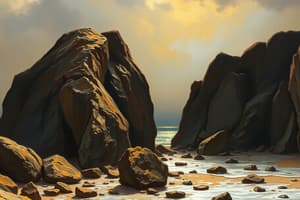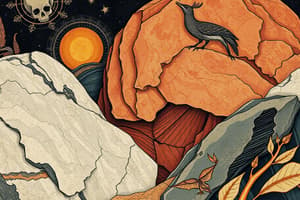Podcast
Questions and Answers
Which process is LEAST likely to directly contribute to the formation of sedimentary rocks?
Which process is LEAST likely to directly contribute to the formation of sedimentary rocks?
- The compaction and cementation of sediments.
- The deposition of sediments in layers.
- The cooling and solidification of lava. (correct)
- The weathering and erosion of existing rocks.
A geologist discovers a rock composed of interlocking crystals formed from the cooling of molten material deep within the Earth. Which type of rock is it MOST likely to be?
A geologist discovers a rock composed of interlocking crystals formed from the cooling of molten material deep within the Earth. Which type of rock is it MOST likely to be?
- Metamorphic rock formed from intense heat and pressure.
- Sedimentary rock formed from cemented sediments.
- Igneous rock that cooled slowly beneath the surface. (correct)
- Extrusive igneous rock that cooled rapidly on the Earth's surface.
Which of the following BEST describes the role of weathering in the rock cycle?
Which of the following BEST describes the role of weathering in the rock cycle?
- It melts rocks to form magma.
- It compacts sediments into rock.
- It breaks down rocks into smaller pieces. (correct)
- It transforms rocks through heat and pressure.
A scientist is examining a rock sample and observes distinct layers containing fossilized shells. Which type of rock is the scientist MOST likely observing?
A scientist is examining a rock sample and observes distinct layers containing fossilized shells. Which type of rock is the scientist MOST likely observing?
Which of the sequences below correctly orders the processes involved in creating sedimentary rock?
Which of the sequences below correctly orders the processes involved in creating sedimentary rock?
A certain rock was once liquid but now it is solid. It is light enough to float on water. How did it form?
A certain rock was once liquid but now it is solid. It is light enough to float on water. How did it form?
A paleontologist discovers a fossil embedded in a rock layer. Understanding the different rock types, what kind of rock would they MOST LIKELY find the fossil?
A paleontologist discovers a fossil embedded in a rock layer. Understanding the different rock types, what kind of rock would they MOST LIKELY find the fossil?
If a rock is subjected to intense heat and pressure, causing its minerals to realign and form a new, denser structure, what type of rock is MOST likely to result?
If a rock is subjected to intense heat and pressure, causing its minerals to realign and form a new, denser structure, what type of rock is MOST likely to result?
Flashcards
Geologists
Geologists
Scientists who study rocks to understand Earth's history.
Sedimentary Rocks
Sedimentary Rocks
Rocks formed from layers of compressed sediment.
Igneous Rocks
Igneous Rocks
Rocks formed from the cooling and solidification of magma or lava.
Metamorphic Rocks
Metamorphic Rocks
Signup and view all the flashcards
Rock
Rock
Signup and view all the flashcards
Rock Cycle
Rock Cycle
Signup and view all the flashcards
Weathering
Weathering
Signup and view all the flashcards
Fossil
Fossil
Signup and view all the flashcards
Study Notes
- Geologists study rocks to learn about Earth's history.
- Sedimentary rocks form from layers of sediment.
- Igneous rocks form from volcanoes.
- Metamorphic rocks form from heat and pressure.
- A rock's physical characteristics come from the way it was formed.
- A rock is a solid piece of the Earth's surface made of one or more minerals.
- A mineral is a natural solid found on Earth's surface that is not plant or animal.
- The processes by which rocks change into new rocks make up the rock cycle.
- Weathering, deposition, compaction, and cementation form sedimentary rock.
- Changing from one rock type to another takes millions of years, which gives scientists clues to the past environment where that rock formed.
- Igneous rocks form from magma.
- When magma erupts from a volcano or comes to the surface, it is known as lava.
- Granite is an example of an igneous rock that forms below the surface.
- Pumice is a rock that is so light it can float on water.
- Sedimentary rocks form from sediment.
- Surface forces break down rocks in a process called weathering.
- Metamorphic rocks form from heat and pressure.
- Fossils form in Sedimentary rock
- Compression is when minerals gradually replace the organism's tissue.
- A paleontologist is a scientist who studies fossils.
Studying That Suits You
Use AI to generate personalized quizzes and flashcards to suit your learning preferences.
Related Documents
Description
Explore the formation and characteristics of sedimentary, igneous, and metamorphic rocks. Understand the rock cycle, including weathering, deposition, and the transformation processes that occur over millions of years. Learn how rock formations offer clues about Earth's past environments.




